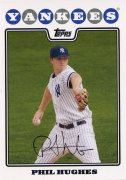Tuesday night’s 9-3 rout of the Oakland A’s was the Yankees’ 82nd victory, thus ensuring their 18th consecutive winning season. That’s a remarkable feat. What’s even more remarkable is that the streak isn’t even halfway to the team’s record of 39 straight winning seasons, done from 1926-64.
Phil Hughes started the game and watching his first few innings over again — isn’t DVR great? — it didn’t look like his stuff was that bad or that he was too far off with location. He wasn’t sharp, to be sure, but he didn’t appear wild enough to have issued five walks. There were some pitches that looked like they painted the outside corner or were within that two- to three-inch window to be called strikes, or were over the plate on the lower border of the strike zone. In short, they were pitches that were close enough that many umpires would have given the benefit of the doubt. The fastball had life, the curveball was good enough to get outs, and the changeups and cutters he mixed in enabled him to pitch out of jams.
More of a concern was the fact that three of the four hits Hughes allowed came when he was ahead in the count. The worst offenses came in the fourth inning, when he grooved an 0-1 fastball to Kevin Kouzmanoff that resulted in a hard single up the middle, and next, after two straight curveballs that kept the bat on Mark Ellis’s shoulder, Hughes threw a belt-high fastball on the outside corner, allowing Ellis to extend his arms and line it to right for a single. This is the same issue, not coincidentally, that has been plagued both of Javier Vazquez’s Yankee tours. A strikeout pitcher has to be able to put away hitters when he’s ahead in the count. Vazquez hasn’t demonstrated that with any consistency this year, and Hughes didn’t on Tuesday.
Michael Kay summed up Hughes’s start in the YES postgame: “When you look at his numbers, 16 wins, how can you complain? But when you watched this game, that’s not the way Phil Hughes wants to pitch.”
Indeed. Despite earning that 16th win, a total which is second-most in the American League, Hughes didn’t do much to instill confidence in Yankee fans that there’s a lock-down guy in the rotation behind CC Sabathia. Hughes seems to be the epitome of why wins can be a misleading stat when rating pitchers. With Andy Pettitte’s injury situation still in flux — he’s throwing another bullpen session before tomorrow’s game — A.J. Burnett as schizophrenic as ever, and any combination of Vazquez, Dustin Moseley, Sergio Meat Tray or even Chad Gaudin behind that, many have been waiting for Hughes to step up and be the No. 2 guy, and he hasn’t. Since the All-Star Break, he is 5-4 with a 4.65 ERA. His performance over the past two starts, particularly the number of pitches thrown — 200 in 8 2/3 innings — is helping to enforce the innings limit. He has thrown 149 1/3 innings now, and figuring he has at least five more starts, if the limit is 175 innings, Hughes is essentially a five-inning starter down the stretch.
Those are the negatives. The positives in this victory were all on the offensive side. The nine runs were scored in the first four innings. Nick Swisher (25th), Curtis Granderson (15th), and Mark Teixeira (30th) all homered for the Yankees, who scored six of those runs with two outs.
Teixeira’s home run marked the seventh straight year he’s hit 30 home runs, and he’s five RBIs away from his seventh straight 100-RBI season. He also scored his Major-League leading 100th run. What a turnaround for Tex. Three months ago, in this space, I wrote a column trying to prove that while Tex’s batting average was hovering near .200 and he was getting a free pass from the mainstream media, we in the blogosphere were not being as dismissive. Now, his average is up to .264 and with a month left, .280 or even .290 isn’t out of the realm of possibility.
Tex’s batting average is now just two points behind that of Derek Jeter, who after another oh-fer has just one hit in his last 25 at-bats and is getting summarily hammered at all angles. Is this the beginning of the end? Is the contract on his mind? How can he command $20 million a year if this is the level at which he’ll be finishing his career? I heard one talkie late last week even compare Jeter’s recent slide to Willie Mays with the Mets in 1973. Are we there yet? I don’t think so. The Yankees have been able to cover for him in the same way they did Teixeira earlier this year, but we’ll see what happens in October.
The other positive of the evening: Toronto blasted Tampa, so the eight-day deadlock atop the AL East is broken. The Yankees hand their longest winning streak since the All-Star break to A.J. Burnett. Maybe a new month and a weak-hitting team is what he needs to get on the path to being right.













